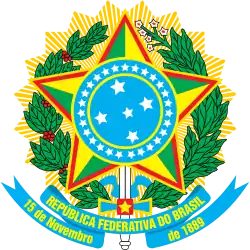| This article is part of a series on the |
 |
|---|
Constitutional Assembly elections were held in Brazil on 3 May 1933 to elect the 214 directly elected deputies of an Assembly that would draw up a new constitution. A further 40 members were indirectly election; 18 by trade unions, 17 by employer organisations, three by members of liberal professions and two by civil servants.[1] The elections have been described as the first democratic or honest elections in the country's history.[2][3]
They were also the first national elections with women's suffrage, although it was still limited to married women, unmarried women with their own income and widows.[4] Carlota Pereira de Queirós became the first woman elected to national office.[4]
Electoral system
The elections were held using open list proportional representation.[5] Voters could cast preferential votes for candidates from multiple parties.[5]
Despite the voting age being reduced from 21 to 18 and women's suffrage being introduced, the number of registered voters fell from 1,893,000 in 1930 to 1,466,700.[6][7]
Results
A total of 1,037 candidates contested the elections.[8]
| Party | Votes | % | Seats | |
|---|---|---|---|---|
| Progressive Party | 31 | |||
| Baía Social Democratic Party | 20 | |||
| Single List for a United São Paulo | 17 | |||
| Social Democratic Party of Pernambuco | 15 | |||
| Liberal Republican Party | 13 | |||
| Radical People's Party | 10 | |||
| Pará Liberal Party | 7 | |||
| Catholic Electoral League | 6 | |||
| Autonomist Party | 6 | |||
| National Party | 6 | |||
| Minas Republican Party | 6 | |||
| Paraíba Progressive Party | 5 | |||
| Maranhão Republican Party | 4 | |||
| Social Democratic Party | 4 | |||
| Republican Social Party | 4 | |||
| Fluminense Progressive Union | 4 | |||
| United Front | 3 | |||
| Freedom and Civics | 3 | |||
| Agriculture Party | 3 | |||
| Catarinense Liberal Party | 3 | |||
| Mato Grossense Liberal Party | 3 | |||
| Socialist National Party | 3 | |||
| Rio Grande do Norte People's Party | 3 | |||
| Social Democratic Party | 3 | |||
| Espírito Santo Social Democratic Party | 3 | |||
| Brazilian Socialist Party | 3 | |||
| Amazonense Civic Union | 3 | |||
| Maranhense Republican Union | 3 | |||
| Baía is still Baía | 2 | |||
| Chapa Popular | 2 | |||
| Economist Party of Brazil | 2 | |||
| Fluminense Socialist Party | 2 | |||
| Liberal Workers' Party | 1 | |||
| Legenda Constitucionalista | 1 | |||
| Legenda Hugo Napoleão | 1 | |||
| Legenda por Santa Catarina | 1 | |||
| Constitutionalist Party | 1 | |||
| Democratic Party | 1 | |||
| Paranaense Liberal Party | 1 | |||
| Republican Social Party | 1 | |||
| Nationalist Social Party | 1 | |||
| Sergipe Republican Union | 1 | |||
| Independents | 2 | |||
| Indirectly elected members | 40 | |||
| Total | 254 | |||
| Valid votes | 1,157,761 | 94.69 | ||
| Invalid/blank votes | 64,863 | 5.31 | ||
| Total votes | 1,222,624 | 100.00 | ||
| Registered voters/turnout | 1,466,700 | 83.36 | ||
| Source: TSE, TSE | ||||
Aftermath
The Assembly began work in November 1933 and the new constitution drafted by the Assembly was promulgated in July 1934. It provided for a federal state with a bicameral parliament, but abolished the position of vice president.[9] The Assembly was then converted into a Chamber of Deputies and elected Getúlio Vargas as president.[9]
References
- ↑ Teresa Cristina de Novaes Marques (2021). Women's Vote in Brazil. p. 94.
- ↑ Michael L. Conniff & Frank D. McCann (1991). Modern Brazil: Elites and Masses in Historical Perspective. p. 33.
- ↑ Riordan Roett (2016). Brazil: What Everyone Needs to Know. pp. 31–32.
- 1 2 "Direito de voto feminino completa 76 anos no Brasil; saiba mais sobre essa conquista". Poder. 24 February 2008.
- 1 2 Jairo Nicolau (2007). "The open-list electoral system in Brazil" (PDF). Dados. 3.
- ↑ Dieter Nohlen (2005). Elections in the Americas: A data handbook, Volume II. p. 173. ISBN 978-0-19-928358-3.
- ↑ "Boletim Eleitoral" (PDF). 13 June 1934.
- ↑ "Eleições 1933". TSE.
- 1 2 Brazil, a Country Study. 1983. p. 41.